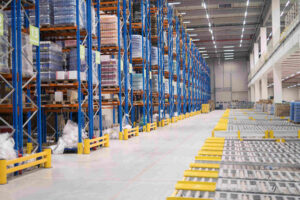
From production to delivery, each and every stage in the supply chain management plays an important in ensuring the goods reach consumers in a timely manner. One vital stage in supply chain management is warehousing. It plays a crucial role in ensuring that goods move efficiently from manufacturers to end-users. Let’s learn more about warehousing in supply chain management and how it works.
What is Warehousing in Supply Chain Management?
So what really is warehousing in supply chain management (SCM)? It is the process of storing goods that will be distributed to end-users later. Warehouses serve as a central hub where goods are received, stored and prepared for shipment to customers or retailers. In other words, the goods are well kept or stored in a large building between the time they are procured and the time they are ready for distribution to customers.
6 Types of Warehouse Storage in Supply Chain Management
There are several warehouses where each type is utilized for a different type of business. Below are the different types of warehouse storage in supply chain management:
1. Private Warehouse
Private warehouses are a popular option of warehouses. These warehouses are usually owned and operated by large companies or manufacturers for exclusive use. Big companies like wholesalers, distributors and manufacturers that have high inventory volume typically have their own private warehouses to store their goods.
2. Public Warehouse
This type of warehouse in supply chain management typically offers temporary storage space for the public. These storage spaces are available for rent by multiple companies. They’re ideal for businesses who need storage space for a short period of time or for businesses who need smaller storage space as other warehouse options may be more expensive for them to invest.
3. Bonded Warehouse
Bonded warehouses store imported goods before customs duties are paid. Due to customs clearance being a lengthy process, bonded warehouses can store goods temporarily while customs clearance is being completed. Besides that, it also allows businesses to defer duties and taxes until the goods are being released for sale or export internationally.
4. Smart Warehouse
A more modernized warehouse is called a smart warehouse where it’s highly advanced with the use of AI. This automated storage space uses the latest technology for efficient, quick, accurate and safe processing and storing of goods. Smart warehouses are often designed to be more sustainable and environmentally friendly, making them a great option for a lot of large businesses especially those in the e-commerce industry with high-volume, fast-moving supply chains.
5. Distribution Centers
Distribution centers, also known as logistic warehouse, have large storage capacities that is capable of moving large quantities of goods in a short period of time. They focus on receiving, storing and quickly dispatching goods to customers. This may be a good option for businesses that deal with perishable goods such as fruits, vegetables and meat.
6. Cold Storage Warehouse
Unlike the other types of warehouses, cold storage warehouses as the name suggests, are used for the storage of temperature-sensitive goods such as fresh produce. These warehouses use temperature control systems to maintain a consistently cold environment, ensuring that the quality and freshness of the goods are preserved and maintained. The low temperatures in the warehouse ensure inventory is safe and the reduced risk of any loss before the goods are transported to their final destination.
For more information that caters to your warehouse storage needs, including general, bonded, and specialized storage for temperature-sensitive and high-value items—visit our 3PL warehouse service page.

Importance of Warehousing in the Supply Chain Management
Warehousing is important in supply chain management as it helps bridge the gap between production and demand and to maintain smooth operations. Here is the role of warehouse in SCM:
1. Inventory Management
Warehouses that are managed well help companies avoid overstocking or understocking their goods. It helps companies to keep track and keep them updated on their inventories. This ensures their inventory is healthy for a well-managed supply chain.
2. Order Fulfillment
Companies can improve their processing time, and reduce delays between orders and distribution with proper inventory management. This increases customer satisfaction.
3. Minimize Cost
Storing goods at a warehouse near your ideal customers can reduce significant shipping costs.
4. Increased Storage Capacity
Warehouses in centralized locations provide sufficient storage for businesses and they can efficiently store their goods safely in large quantities whether they are raw materials or finished goods before they are distributed.
5. Risk Mitigation
Investing in a properly managed warehouse for your goods can help provide security against damage, theft and natural disasters.
How Supply Chain Management Benefits from Warehousing
Below are some ways supply chain management can benefit from warehousing:
1. Faster Delivery of Goods
To ensure quicker delivery of goods, storing goods closer to customers can help maintain the supply chain, reducing time and improving customer satisfaction.
2. Cost Savings
When goods are handled efficiently with care, it minimizes waste and thus, reduces cost. Plus, it also reduces transportation costs when bulk shipments are being used, reducing the need for frequent deliveries.
3. Improved Inventory Management
Warehouses that are well managed can provide real-time tracking and management of goods. This allows businesses and companies to keep track of stock levels at any given time.
4. Strategic Location
Choosing a warehouse location that is nearer to your customers can improve the efficiency of supply chain management. This helps with the seamless flow of the supply chain, allowing quicker deliveries and avoiding delays.
Read more about the benefits of outsourcing a warehouse service for businesses here.
Impact of Warehousing on Supply Chain Efficiency
Warehousing can significantly boost supply chain efficiency and enhance operational productivity. Here’s how warehousing impacts supply chain efficiency:
1. Facilitate Flexibility
Companies can store excess products, enabling them to manage fluctuating demand or market changes that are sudden without production delays or stock shortages.
2. Speed up Distribution
Warehousing with proper management can provide real-time tracking of inventory data, preventing any sort of delay and minimizing shortage of stocks, helping in optimizing both the speed and accuracy of distribution of the goods. Orders can be processed efficiently and more quickly when inventory is accurately tracked.
3. Enhance Order Accuracy
Using technology such as barcode scanners, RFID systems or AI such as robotics or drones, can help warehouses to precisely locate, pick and pack items, ensuring customers receive the right products, thus enhancing order accuracy. This way, it enables faster, more consistent operations while reducing the risk of misplacements or incorrect orders.
Global Track Lines for 3PL Warehouse Service
As you know now warehousing is one of the important stages of successful supply chain management, it’s important to choose the right and efficient warehousing solution for your business.
If you’re looking for a reliable warehouse storage in Malaysia, Global Track Lines offers efficient warehouse service in Malaysia and distribution in Port Klang. We specialize in handling general storage, long-term storage, bonded warehouse, and cold storage for sensitive goods, safe and secure in the hands of our experts. Our experienced team will work closely with you to understand your requirements and provide customized warehousing solutions that improve efficiency and minimize costs.
To learn more about how we can help you with all your warehouse needs, contact us today!


